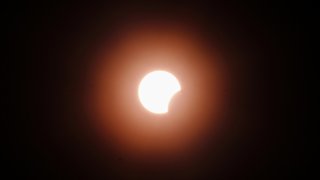
ACEH, INDONESIA – JUNE 21 2020 : A partial solar eclipse was seen in the sky of Lhokseumawe City, on June 21, 2020, in Aceh Province, Indonesia.- PHOTOGRAPH BY Fachrul Reza / Barcroft Studios / Future Publishing (Photo credit should read Fachrul Reza/Barcroft Media via Getty Images)
Parts of North America will be treated to a celestial show this week, as a “Ring of Fire” annular solar eclipse is set to take place early Thursday morning, but where should Chicagoans go if they want to catch a glimpse of the event?
According to astronomers, the eclipse will last for just over an hour, and most of the northeastern part of the United States and Canada will be able to catch a glimpse of at least some of the spectacle.
The Chicago area is on the far southwestern side of the region where the eclipse will be visible, but astronomers say that the eclipse will peak before the sun comes up, giving Chicagoans only a limited viewing window.
Despite that, the sun will still be at least partially covered by the moon once it rises above the horizon at 5:18 a.m., giving residents a chance to see a partial eclipse before the moon finishes passing through the path of the sun at approximately 5:39 a.m.
Feeling out of the loop? We'll catch you up on the Chicago news you need to know. Sign up for the weekly Chicago Catch-Up newsletter here.
So if Chicago area residents want to see the eclipse, where will they need to go?
Simply put, residents will need to find a space with an unobstructed view of the northeastern horizon, and one of the best places to do so would be along the shores of Lake Michigan says Michelle Nichols, director of public observing at Chicago’s Adler Planetarium.
“The best place to go see this is anywhere where you have a clear view of the northeastern horizon, right down to that horizon,” she says. “This will be over just 20 minutes after sunrise. Anywhere on the lakefront (along Lake Michigan) would be good. Anywhere you can get up on a little rise or a hill, because you don’t want buildings and you don’t want trees in the way.”
Local
Nichols says that residents outside of Chicago can potentially visit parks on the outskirts of towns, with no obstructions on the horizon. Parking lots with open views of the northeastern horizon could also work, she says.
For residents able to find a suitable place to watch the eclipse, there is one other critical thing to remember: eye protection is an absolute must. A safe solar viewer from a reputable vendor, including eclipse glasses that were sold prior to the 2017 total solar eclipse that took place in the skies above Illinois, is a necessity, and Nichols advises that residents test their glasses before trying to view Thursday’s eclipse.
“As long as you’ve kept them dry and safe, and there’s no pinholes or scratches in the glasses material, and you can just shine a really bright flashlight and not see through them, you’re good,” she says.
While some partial and total eclipses can be viewed by using two paper plates, projecting the image by punching a hole in one and shining it on the other, Nichols says that there likely won’t be enough light at sunrise to enable viewers to see the eclipse in that fashion.
She says that it’s unclear just how visible the eclipse, which is only set to cover about a third of the sun by the time it rises in Chicago, will be in the area.
“The only way to do it is to try it, so give it a whirl,” she says.
Sunrise in Chicago is set for 5:18 a.m. Thursday, and the eclipse will already have passed its halfway point by the time Chicagoans will be able to see it. Residents will have approximately 21 minutes to see the eclipse before the moon moves away, according to astronomers.
For those interested in a fuller view of the eclipse, several websites will offer livestreams of the event, including Virtual Telescope TV.